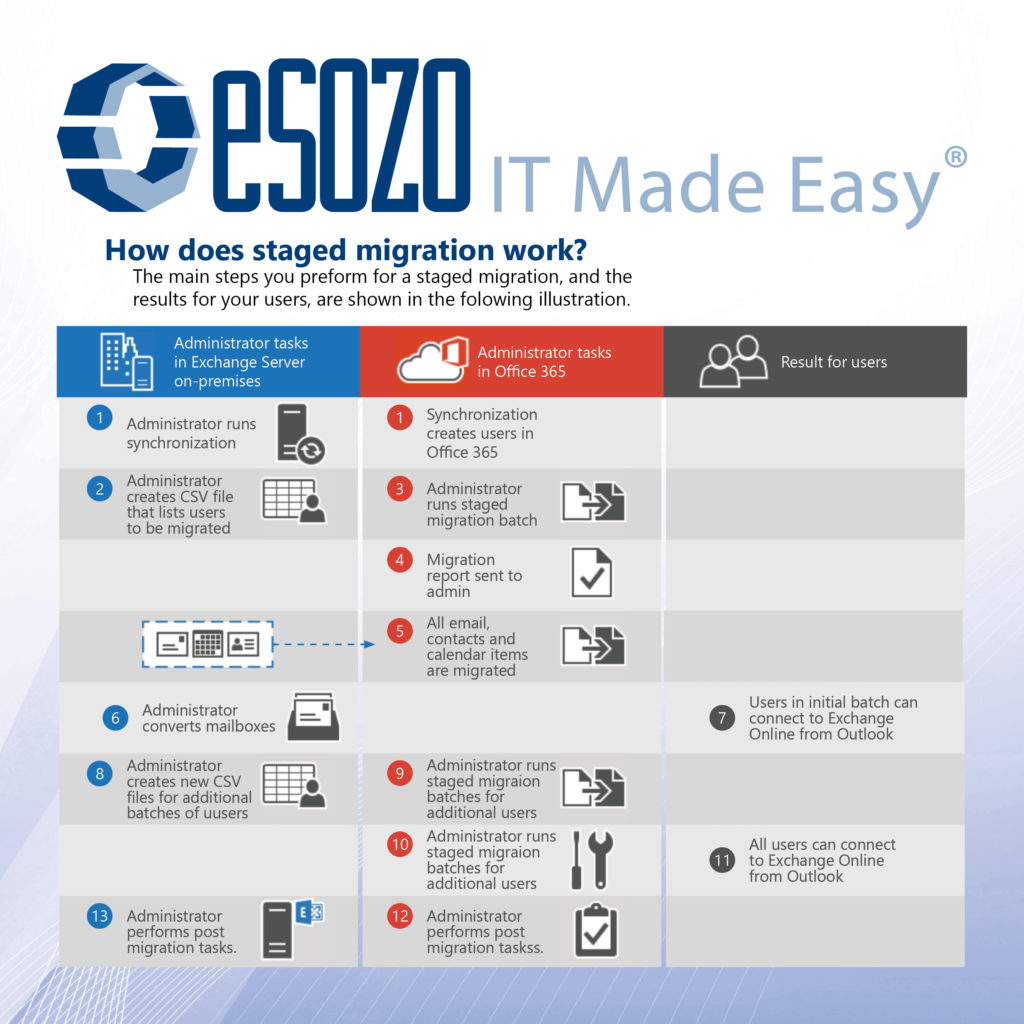If you’re not getting what you need to know about a staged email migration to Office 365, please read on – you’ll probably find this information invaluable. After all, an Office 365 staged migration guide like the one we’re presenting here could save you incalculable time and trouble down the road when you attempt to retrieve email communications and have your office all be on the same page.
As part of an Office 365 deployment, you can migrate the contents of user mailboxes from a source email system to Office 365. When you do this over time, it’s called a staged migration. A staged migration is recommended when:
- Your source email system is Microsoft Exchange Server 2003 or Microsoft Exchange Server 2007.
- You have more than 2,000 mailboxes.
NOTE: You can’t use a staged migration to migrate Exchange 2013 or Exchange 2010 mailboxes to Office 365. Consider using a cutover migration or a hybrid email migration instead.
If a staged email migration doesn’t work for you, see Ways to migrate email to Office 365 for other options.
Other Things to Consider When Doing a Staged Migration of Office 365
Here are a few items to be aware of when considering doing an Office 365 staged migration:
- You must synchronize accounts between your on-premises Active Directory domain and Office 365 by using Azure Active Directory sync for a staged migration to work.
- The primary domain name used for your on-premises Exchange organization must be a domain verified to your Office 365 organization.
- You can migrate only user mailboxes and resource mailboxes. Other recipient types, such as distribution groups, contacts, and mail-enabled users are migrated to Office 365 through the process of directory synchronization.
- Out of Office messages aren’t migrated with user mailboxes. If a user turns on the Out of Office feature before the migration, the feature will remain enabled on the migrated mailbox, but the Out of Office message is blank. People who send messages to the mailbox won’t receive an Out of Office notification. To allow Out of Office notifications to be sent, the user needs to recreate the Out of Office message after the mailbox is migrated.
- If you have limited the connections to your source email system, it’s a good idea to increase them to improve migration performance. Common connection limits include client/server total connections, per-user connections, and IP address connections on either the server or the firewall. If you didn’t limit these connections, you can skip this task.
Impact of an Office 365 Migration to Users
Administrators can access email, and so to migrate email, you need access to the user mailboxes in your source email system.
Users must create new Outlook profiles. After the mailboxes are migrated, and the on-premises accounts are converted to mail-enabled accounts, the users must create a new Office 365 profile in Outlook, and then Outlook automatically connects to Office 365.
How Does Office 365 Staged Migration Work?
The main steps you perform for a staged migration, and the results for your users, are shown in the following illustration:
Here’s a description of the Office 365 staged migration shown in the following illustration:

- The administrator synchronizes the list of users between their on-premises environment and Office 365. See how-to steps in Prepare for a staged migration.
- The administrator creates a comma-separated value (CSV) file that contains a row for each user whose on-premises mailbox will be migrated in the migration batch. See how-to steps in Create a list of mailboxes to migrate.
- The administrator creates and runs a staged migration batch by using the migration dashboard in the Exchange admin center.
See how-to steps in Connect Office 365 to your email system, Migrate your mailboxes, and Start the staged migration batch.
After the administrator starts the migration batch, Exchange Online does the following:
- Verifies that directory synchronization is enabled.
- Checks that a mail-enabled user exists in the Office 365 organization for each user listed in the CSV file. Mail-enabled users are created in Office 365 as a result of the directory synchronization process.
- Converts the Office 365 mail-enabled user to an Exchange Online mailbox for each user in the migration batch.
- Begins initial synchronization. Exchange Online processes up to N migration requests at one time. N represents the maximum number of concurrent migrations that the administrator specified when creating the migration endpoint used for the migration batch. By default, initial synchronization is performed on 20 mailboxes at a time until all mailboxes in the migration batch are migrated.
- Configures mail forwarding. The Target Address property on the on-premises mailbox is configured with the email address of the Exchange Online mailbox. This process means that mail sent to the on-premises mailbox is forwarded to the corresponding Exchange Online mailbox.
- After it creates the Exchange Online mailbox and configures mail forwarding for each user in the CSV file, Exchange Online sends a status email message to the administrator. This status message lists the number of mailboxes that were successfully migrated and how many couldn’t be migrated. The message also includes links to migration statistics and error reports that contain more detailed information. At this point, users can start using their Exchange Online mailboxes.
- As part of initial synchronization, Exchange Online then migrates all email messages, contacts, and calendar items from the on-premises mailboxes to Exchange Online mailboxes. Exchange Online sends a final migration report when the data migration is complete.
- After a migration batch is complete and the administrator verifies that all mailboxes in the batch are successfully migrated, the administrator can convert the on-premises mailboxes to mail-enabled users.
See how-to steps in Convert on-premises mailboxes to mail-enabled users.
There are more steps involved things to know when doing a safe staged migration of Office 365, and eSOZO can help you do it the right way.
Ready to Get Started with Your Office 365 Staged Migration?
If you’re ready to begin an Office 365 staged migration, you can use the steps given in Perform a staged migration email to Office 365 yourself, and/or give eSOZO a call at (888) 376-9648 or email us at info@esozo.com and let us walk you through it if you’re at all in doubt about being able to perform each step.
Author: Aaron White, Date: 6th November 2017




Follow eSOZO on Social Media